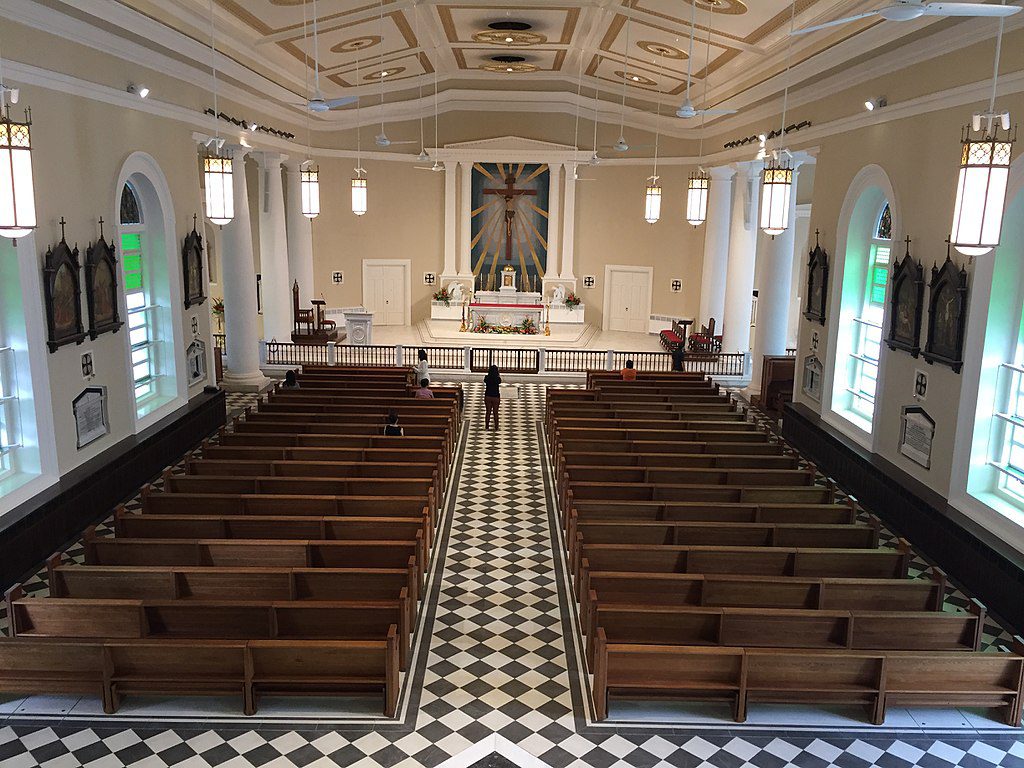
SINGAPORE (UCAN): A time capsule found beneath the Cathedral of the Good Shepherd in Singapore five years ago contains 18th and 19th century artifacts that preserve pieces of the history of the city-state.
The Archdiocese of Singapore recalled the great discovery in a Facebook post that drew hundreds of likes, comments and shares.
“In 2016, midway through a $38 million restoration of the Cathedral of the Good Shepherd, the contractors discovered a time capsule buried some 173 years before. The shoebox-sized pit it was found in was under a column base on a series of granite steps along the cathedral’s Victoria Street facade,” said the post dated August 25.
“It was sealed by a cornerstone and contained 18th and 19th-century artifacts such as 24 British, French and Spanish coins, a copy of the Singapore Free Press, the Straits Messenger, the Bengal Catholic Herald, the Madras Catholic Expositor and a religious service booklet. The rare historical artifacts are now displayed at the cathedral’s heritage gallery.”
Netizens have expressed joy over the invaluable artifacts.
“How wonderful to find the cornerstone of the cathedral, the base and foundation holding together the walls of the church. They had a special blessing for the cornerstone of the church. Very meaningful. Christ is our cornerstone. Amen!” Joy Aroozoo Olsen commented.
The discovery stirred up quite a buzz in Singapore and beyond, making headlines in local and international press.
The Catholic News of the ardiocese reported on 29 June 2016, that workers carrying out restoration work on the cathedral discovered the cornerstone and the time capsule.
The 22 June 1843, edition of the Singapore Free Press recorded that French Bishop Jean-Paul-Hilaire-Michel Courvezy of the Paris Foreign Missions Society [MEP] had presided over the cornerstone-laying ceremony of Singapore’s oldest Catholic church.
The artifacts included a painting of French MEP missionary, St. Laurent Imbert, who visited Singapore in 1821, which marked the official beginning of the Catholic Church in the country. Father Imbert later went on to serve in Korea as a bishop and was martyred on 21 September 1839
Among those present were Father Jean-Marie Beurel mep, and John Connolly, a merchant who offered great financial support to the building of the church, according to Catholic News.

Photo: Sensicalchinks/Wikipedia, CCBY-SA 4.0
The artifacts included a painting of French MEP missionary, St. Laurent Imbert, who visited Singapore in 1821, which marked the official beginning of the Catholic Church in the country. Father Imbert later went on to serve in Korea as a bishop and was martyred on 21 September 1839.
The name of the Cathedral of Good Shepherd has its origins in a note from St. Imbert to fellow missionaries in which he wrote: “In desperate circumstances, the Good Shepherd lays down his life for his sheep.”
The Church in Singapore started year-long celebrations of the 200th anniversary of the advent of Catholicism in the country on 13 December 2020. They will conclude on December 11 this year.
The theme for the jubilee year is Ignite and Shine with Faith—in line with the pastoral vision of the Archdiocese of Singapore. Although curtailed due to Covid-19, the jubilee events focus on renewing the faith of the Catholic community through four aspects: deepen, discern, witness and celebrate.
Singapore was a Malay fishing village before Sir Stamford Raffles made it a British colony in 1819. Soon afterwards, Catholic missionaries arrived and the Catholic Church is credited with vital contributions in nation building through education, health care and social welfare.
With a population of about 5.6 million, Singapore is a multi-ethnic and multi-religious country. Most Chinese are Buddhists and most Malays are Muslims. Christians comprise about 15 per cent of the population.
The Archdiocese of Singapore has 360,000 Catholics spread across 32 parishes.








